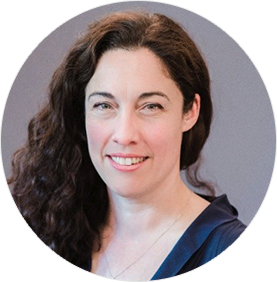Episode 74: Caroline Holt on Maximizing Collaboration with Revenue Enablement
3.7K Views | 21 Min Read
Shawnna Sumaoang: Hi, and welcome to the Sales Enablement PRO podcast. I am Shawnna Sumaoang. Sales enablement is a constantly evolving space, and we’re here to help professionals stay up to date on the latest trends and best practices so they can be more effective in their jobs.
Today, I’m excited to have Caroline join us. Caroline, I’d love for you to just introduce yourself, your role, and your organization.
Caroline Holt: Sure. My name is Caroline Holt. I’m the EVP of revenue enablement for EVERFI, which is a global company based in Washington, D.C.
SS: And can you explain to our audience a little bit about what the revenue enablement function looks like at EVERFI? How is it structured and segmented to support all of the revenue teams across sales, account management, customer success, and others?
CH: Sure. So, let me tell you a little bit about our organization because I think that helps with understanding the revenue org. We are an education company. We’ve been around for about 12 years, we actually got started during the financial crisis. And what we do is we build social impact education programs for originally K-12 students. And now we sell a lot of our preventative solutions in challenges like sexual harassment and alcohol and drug awareness and prevention on campuses, so we actually work with businesses, colleges, and universities, as well as K-12 institutions.
What we’ve done is historically, we’ve had a vertical focus. If we were selling to the higher ed space, we’ve had a revenue team and an account management team that has supported that group. And then in 2019, we brought in our first chief revenue officer who had responsibility for all of those verticals reporting up into him.
So, Bobby Moran who is our CRO, as part of what he is doing to try and change our growth trajectory in an even more positive direction. That’s been great, but we’re looking at how to grow to the next $200 million. He has aligned around first having all of sales and account management report up through one person ultimately, and then have a number of centralized services that support each of those revenue teams. So, we’re still selling all of the products that we have historically, but we’re making sure that we’re able to achieve scale through centralized services.
For my team, which is revenue enablement, I work closely with the talent and HR team on getting the profile right for our sales folks, making sure that we’re hiring the right people, we have the right recruiting systems and processes in place. My team has responsibility for the sales onboarding, development, and readiness.
The second part of my team, which we call “revenue assets”, has responsibility for all of the prospect and customer-facing tools. So, be those business intelligence tools like tech tools, or the actual collateral that reps are using. That part of my team works closely with marketing, works closely with revenue leaders, works closely with revenue operations, making sure that we have the right tools and materials that we need.
And then the third part of my team, we do a fair amount of requests for proposal. So, while we run traditional sales processes, we also have RFPs that we’re addressing largely for state and federal. But for state institutions, a lot of our higher education clients use the request for proposal process. So, we’ve got a part of my team that does RFP responses and due diligence requests as a tech provider that supports highly regulated industries. We have a lot of due diligence work that we do as well.
SS: Fantastic. Now in your opinion, what are the core components of a revenue enablement function?
CH: A lot of what I do is actually partially designed by me, which is kind of cool. As Bobby came in and we were looking at the best way to optimize revenue enablement in 2020, we looked at where we had some critical challenges as a business, but also across all industries, what revenue enablement looks like. With this podcast, revenue enablement is kind of a relatively new term. Sales enablement, revenue enablement — it means a lot of things to a lot of different companies. So, for some companies it means sales training. For other companies, it means revenue operations and kind of the data piece. Then for other companies, that means something entirely different.
While we try and figure out exactly what that means across all businesses and industries, what I fundamentally believe needs to be in the core components of revenue enablement are a combination of ensuring that we know exactly what we’re trying to do as a business and making sure that all the pieces that enable revenue to be successful to make those goals and objectives are working in concert. So, that’s the combination of all of those great people across the business. Revenue enablement in my mind is really the way to maximize cross-functional collaboration to support the revenue generation for the business.
So, it’s not as easy as training or revenue operations and data. It’s kind of how all those pieces play together and ensuring that the rep then has the tools that they need to understand what the business objectives are, how they get there, what tools they need to be successful, and then how to make sure that that customer experience is as strong as possible so that we are ultimately able to renew that customer and grow them over time.
SS: I love that. And I think that segues really nicely into my next question. Who are some of the core partners that you work with and need to get buy in from in order to deliver successful revenue enablement programs?
CH: Sure. I just literally walked out of an hour and a half of training that I did where our chief product officer was saying, “I don’t know what we did before you got here.” I work really closely with all of the C-suite folks across of our business that have some impact on the revenue organization, which is pretty much everyone, right? So, whether it’s the head of HR, whether it’s the head of product, whether it’s the head of marketing, and then all of their teams, right?
I am in some ways an internal customer to some of those folks in other ways. They are my internal customer, so I need to make sure that everybody is rowing in the same direction. So, the training that I just came out of was, we’re a SaaS company, but we have this whole professional services component. Part of what many of our revenue folks didn’t quite understand is how our budgets are built.
When we bring in bespoke or custom project builds to do, they’re really sexy, really cool, they’re really expensive in terms of what we are able to often command as a price point. But on the product side, that puts a disproportionate amount of pressure on that group to deliver on new pieces that weren’t actually on the roadmap to start with. So, what our product side was feeling is anxiety around what they needed to be able to deliver for our current customers and what we needed to be able to deliver and have a margin on from a SaaS perspective.
And then what our sales team was excited about was, “Hey, we’re bringing in all these things. Why aren’t we Earmarking money in order to develop and build these?” The cross-functional work that we just did took a couple of weeks. It was a combination of the COO, the head of product, the head of product’s whole team, the sales engineering team, some members from our revenue team, and our finance team as well. We wanted to tell the story of what it means to be a SaaS company, how we make money as a SaaS company, how we identify what goes onto our product roadmap in terms of innovation and maintenance and renovation of our products, plus new development.
And then, what it is that they actually have to sell currently because what we were starting to get the impression was that because people didn’t know exactly what was in their bag, they were actually defaulting to more of a customized approach than they really needed. So, we wanted them also to learn about what was actually in their bag that they had, why it was powerful, and create some new collateral that helped them be able to navigate it. Because lot of the materials that could have answered those questions lived in a lot of different places or in people’s heads. So, I’m using this example because I think people think about revenue enablement being training or revenue enablement being sales force data, but what they’re missing out on, is that it’s really the opportunity to bring all these key stakeholders to the table and understand where the pressure points or pain points are.
So, the revenue person who’s feeling like the product team just doesn’t get stuff into my hands quickly enough, it’s sexy enough for what our prospects and customers need — they are missing why that’s happening on the other end. My job is to help understand where those pressure points are, why those are challenges, how we fix them in the business, where we make priorities and trade-offs, and then make sure that people have both the knowledge and skill to be able to execute on that effectively, the collateral or tools to then be able to tell that story to the market, as well as some of the accountability to then say, “now that we’ve done this, if you’re continuing to do this in the same way, then we haven’t actually made the behavior change that we want.”
And so that either comes back to me as we have to keep working on that or that the skill or will isn’t there somehow, or the wheel perhaps isn’t there.
SS: And I think to that point when you’re partnering with so many different functions across the organization, alignment is hyper-critical. How can that alignment help scale the success of sales enablement initiatives?
CH: Most of my skillset from a sales enablement perspective comes a lot from my skillset as a high performing salesperson, right? So, if you build a product and you go in and tell a prospect or customer that they should buy this product and here’s why, and here’s what’s really great about it, and you take them through all the features and functionality, some of them will buy your product. There’s a certain percentage of them in that situation who will say, “yeah, that’s great. I’ll buy that.” There’s a whole lot of them that will say, “I’m not interested.”
Similarly in sales enablement, if we go in and say, “here’s what we believe the solution is and here’s why, and here’s how I’m going to fix it and here’s what I’m going to do,” we miss the opportunity to do the needs assessment to understand what’s actually a challenge for that particular internal or external constituency. Why it’s a challenge, how it’s presenting for them, what their understanding of the situation is, what they believe might need to be fixed. If you start with what you think the answer is, you tend to miss out on that needs assessment and we go right to the value. Therefore, we’re trying to sell at somebody as opposed to sell with someone or work collaboratively on something.
I think that a big part of alignment is understanding both what does that person or that team need to get accomplished? What is it that they need to get out of the revenue organization or the sales organization? How does the revenue organization or sales organization affect them? How do you start to create that collaboration and alignment on business objectives? Then that starts to trickle into what we actually need to accomplish together. I think if you understand the needs of your internal stakeholders, and they understand what’s in it for them to work together, it’s a lot easier to build something in a collaborative zone.
Even if you know what you think the direction is that you want to take from a revenue perspective or revenue enablement perspective, it gives you more clarity and it enables you to work much more closely together because you feel like you have similar consensus-based objectives as opposed to, “this is the stuff that the revenue team needs to get done and here’s how I need you to help me get that done.” Which feels a lot more like, I’m either going in and selling them something or I’m going in and telling them that they need to get on board. It’s tough to create that interest if they are feeling “volun-told” as opposed to a collaborative part of the solution.
SS: Absolutely. I want to pivot this a little bit, because I think there’s a lot of interest from enablement practitioners on getting a seat at the table with the executive leadership team to help build the business case for enablement programs. do you believe that positioning your team as a revenue enablement team versus perhaps maybe a sales enablement team is helping in that effect?
CH: I think when we talk about sales enablement, typically the connotation of sales enablement is new logo. I think that does a huge disservice to, in particular, my role — but most revenue organizations’ roles, which include new logo, upsell, and renewal. And a lot of the sales skills or commercial skills that a revenue generator, who’s got a renewal responsibility or a book of business, it really undervalues their contribution.
For me, I have a revenue enablement title because I report up through the CRO. I have responsibility for both the net-new and renewal as well as the upsell enablement for the business — which has got a training component and asset component and a proposal/due diligence component. To the point of having a seat at the table, and to the point that I made earlier about the alignment piece, I think if I’m trying to position myself for what the organizational objectives are, that’s the best way to get a seat at the table, right? If I understand what the business is trying to accomplish and how enablement, whatever you call it, plays a role in that, I have a much better likelihood of getting a seat at the table.
But then more specifically from a revenue perspective, if I’m only focused on the net-new or sales side, then I’m less likely to have a seat at the table or be a trusted advisor to the entire revenue process. I’m more likely to be seen as the person who’s there to support net-new, which is a lot tougher to break in the first time from the renewal. That is not at all to say that renewals are easy, so it is easier for us to cultivate, develop, give a great customer experience to somebody that we’ve worked really hard to bring in the door and get as much as we can out of that lifetime value of that person. And I think sales enablement often focuses far too heavily on getting new logos into the business and not as much on the critical development support and engagement of the commercial teams that have responsibility for the renewal and an upsell of their existing customer base.
SS: Fantastic. And I think you’re right. I think that’s a really great shift in mindset. Now, in closing, last question for you, what are some of the key metrics you think are most important to demonstrate the success of revenue enablement initiatives?
CH: Oh, that’s a fun one. I think that every initiative — and this also gets to the point about getting a seat at the table — understanding what the business objectives are is the most critical piece of all of this. Whatever the initiatives are that the revenue enablement team or sales enablement team is focused on needs to have a direct, visible impact on some of those metrics.
So, I would say that obviously the lagging metric is always revenue generation itself. Are we able to convert more quickly? Of the meetings that we schedule, whether they’re net-new or upsell, how many of those turn into opportunities? Of those that turn into opportunities, how many do we ultimately win? Of the meetings that we do, how many of them do we ultimately convert? What’s our conversion rate? What’s our average price point? So, are we seeing those numbers increase? Are we seeing the sales cycle time decrease? From the time that we first start talking to somebody, until we actually close that opportunity, are we seeing those numbers shrinking while most other things are increasing?
Are we increasing the number of titles that fit into our ideal customer profile? I think this is actually an undervalued but really fundamental piece. How many of the people that we should be talking to are we actually talking to? How many of the people we should be engaging with are actually our principal points of contact at our customer organizations? Most sales enablement organizations aren’t thinking as much about that piece. So, those are some of the metrics that I am interested in. Whether it’s training programs or assets, are those designed to support those critical metrics that we care a lot about as a business?
For us at EVERFI, we’re a SaaS company, right? So, another metric that’s really important to us is our margin. When we build a product and then sell it or license it to companies, the more times we’re able to do that a 75-80% margin, which is great within SaaS, right? So, how many of our customers are we serving at less than a 75% margin? And through the work that my team is doing, are we actually increasing that? Are we increasing our win rate on our proposals that are going through RFP? What is the actual capture rate of those?
So, there are lots of really great metrics. I think that it always comes down fundamentally — and the way that you get the seat at the table again goes hand-in-hand with us – is what are the metrics that the business is trying to accomplish this year? And then how do the programs, the tools, the assets, the resources that you have to support the sales organization enable them to do that more effectively?
SS: I love that. Well, Caroline, thank you so much for joining us today. I think the team that you’re building there is very forward-leaning, so kudos to you. And thank you so much for joining us today.
CH: Thank you. It’s been a pleasure to be here.
SS: To our audience, thanks for listening. For more insights, tips, and expertise from sales enablement leaders, visit salesenablement.pro. If there’s something you’d like to share or a topic you’d like to learn more about, please let us know. We’d love to hear from you.


















